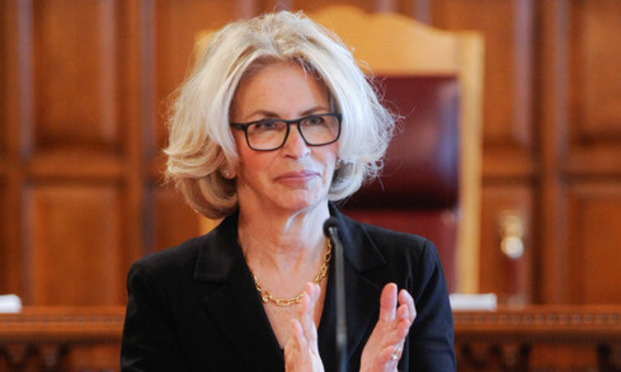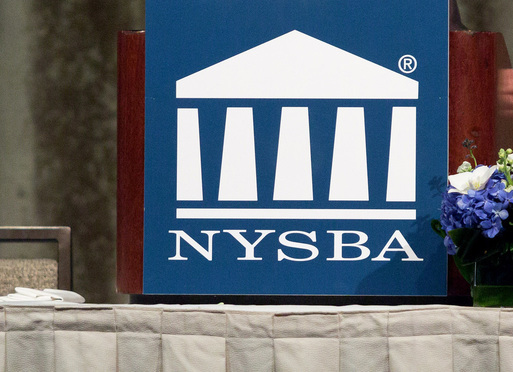State, County Bar Associations to Take Over Screening of Judicial Candidates
"Having effective, partisan-free judicial evaluation and screening processes in place throughout the state is critical to ensuring that candidates for judicial office in New York possess the essential qualities to be a good judge," Chief Judge Janet DiFiore said in a statement that the New York State Bar Association is planning to release on Thursday.
April 17, 2019 at 04:52 PM
4 minute read
 New York Chief Judge Janet DiFiore. Photo: Tim Roske
New York Chief Judge Janet DiFiore. Photo: Tim Roske
Candidates for judicial office will no longer be rated by commissions appointed by the chief judge, ending a vetting process that has been in place for 15 years.
Instead, state and county bar associations will take over screening. In New York City and some populated parts of the state, bar associations were already interviewing and recommending candidates in addition to the evaluations of the court-appointed Independent Judicial Elections Qualification Commissions.
The court-appointed commissions were unpopular and some judicial candidates refused to participate, saying the process of being vetted by multiple bar associations was onerous. Critics complained that a court-appointed commission could not be impartial.
“The obvious concern is some people might look at it like incumbent judges favoring other incumbent judges,” said Robert Haig, a partner at Kelley Drye & Warren who was one of the chairs of the state bar association's task force on judicial vetting.
Chief Judge Janet DiFiore disbanded the commissions at the end of 2018 because she agreed that the process was flawed, said Lucian Chalfen, director of public information for the Unified Court System. It fell to the state bar association to make recommendations for a new evaluation system to replace the court-appointed one.
The state bar association's House of Delegates, meeting in Albany on Saturday, voted 51-48 to recommend that bar associations use a three-tier or two-tier evaluation system. The task force had favored a two-tier system.
The three categories—well-qualified, qualified and not approved—allow the evaluators to give more credit to an experienced judge over a qualified challenger with no judicial experience if they wish to make such a distinction. Judges who were members of the state bar's judicial section felt this would be fairer to incumbents. The two-tier system was a pass-fail with ratings of approved or not approved.
“Having effective, partisan-free judicial evaluation and screening processes in place throughout the state is critical to ensuring that candidates for judicial office in New York possess the essential qualities to be a good judge,” DiFiore said in a statement that the New York State Bar Association is planning to release on Thursday along with the recommendations of its task force.
The task force, chaired by Haig and retired Court of Appeals Judge Susan Phillips Read, of counsel to Greenberg Traurig, found that the evaluation systems in place in most of the state are effective. But the bar association is offering its expertise to more rural parts of the state that need to put regional and countywide screening processes in effect.
“If you have a system that's working well now we are not saying that you should change it,” Read said.
The task force noted that its mission did not include tackling a split in the way judges in New York are selected: the state's appellate courts and the New York City Criminal and Family Court judges are all appointed; nearly all other judges and justices are elected. The state bar association supports a commission-based selection process for all judges, similar to the one used to appoint judges to the Court of Appeals.
Read More:
Task Force on the Evaluation of Candidates for Election to Judicial Office
 New York State Bar Association
New York State Bar AssociationThis content has been archived. It is available through our partners, LexisNexis® and Bloomberg Law.
To view this content, please continue to their sites.
Not a Lexis Subscriber?
Subscribe Now
Not a Bloomberg Law Subscriber?
Subscribe Now
NOT FOR REPRINT
© 2025 ALM Global, LLC, All Rights Reserved. Request academic re-use from www.copyright.com. All other uses, submit a request to [email protected]. For more information visit Asset & Logo Licensing.
You Might Like
View All

Justice Marguerite Grays Elevated to Co-Chair Panel That Advises on Commercial Division

Distressed M&A: Safe Harbor Protection Extends to Overarching Transfer

Trending Stories
- 1Digital Assets and the ‘Physical Loss’ Dilemma: How the Fourth Circuit’s Ruling on Crypto Theft Stands at Odds With Modern Realities
- 2State's Expert Discovery Rules Need Revision
- 3O'Melveny, White & Case, Skadden Beef Up in Texas With Energy, Real Estate Lateral Partner Hires
- 4Chamberlain Hrdlicka Taps a New Leader as Firm Follows Succession Planning Path
- 5Smaller Firms in 'Growth Mode' as Competition, Rates Heat Up
Who Got The Work
J. Brugh Lower of Gibbons has entered an appearance for industrial equipment supplier Devco Corporation in a pending trademark infringement lawsuit. The suit, accusing the defendant of selling knock-off Graco products, was filed Dec. 18 in New Jersey District Court by Rivkin Radler on behalf of Graco Inc. and Graco Minnesota. The case, assigned to U.S. District Judge Zahid N. Quraishi, is 3:24-cv-11294, Graco Inc. et al v. Devco Corporation.
Who Got The Work
Rebecca Maller-Stein and Kent A. Yalowitz of Arnold & Porter Kaye Scholer have entered their appearances for Hanaco Venture Capital and its executives, Lior Prosor and David Frankel, in a pending securities lawsuit. The action, filed on Dec. 24 in New York Southern District Court by Zell, Aron & Co. on behalf of Goldeneye Advisors, accuses the defendants of negligently and fraudulently managing the plaintiff's $1 million investment. The case, assigned to U.S. District Judge Vernon S. Broderick, is 1:24-cv-09918, Goldeneye Advisors, LLC v. Hanaco Venture Capital, Ltd. et al.
Who Got The Work
Attorneys from A&O Shearman has stepped in as defense counsel for Toronto-Dominion Bank and other defendants in a pending securities class action. The suit, filed Dec. 11 in New York Southern District Court by Bleichmar Fonti & Auld, accuses the defendants of concealing the bank's 'pervasive' deficiencies in regards to its compliance with the Bank Secrecy Act and the quality of its anti-money laundering controls. The case, assigned to U.S. District Judge Arun Subramanian, is 1:24-cv-09445, Gonzalez v. The Toronto-Dominion Bank et al.
Who Got The Work
Crown Castle International, a Pennsylvania company providing shared communications infrastructure, has turned to Luke D. Wolf of Gordon Rees Scully Mansukhani to fend off a pending breach-of-contract lawsuit. The court action, filed Nov. 25 in Michigan Eastern District Court by Hooper Hathaway PC on behalf of The Town Residences LLC, accuses Crown Castle of failing to transfer approximately $30,000 in utility payments from T-Mobile in breach of a roof-top lease and assignment agreement. The case, assigned to U.S. District Judge Susan K. Declercq, is 2:24-cv-13131, The Town Residences LLC v. T-Mobile US, Inc. et al.
Who Got The Work
Wilfred P. Coronato and Daniel M. Schwartz of McCarter & English have stepped in as defense counsel to Electrolux Home Products Inc. in a pending product liability lawsuit. The court action, filed Nov. 26 in New York Eastern District Court by Poulos Lopiccolo PC and Nagel Rice LLP on behalf of David Stern, alleges that the defendant's refrigerators’ drawers and shelving repeatedly break and fall apart within months after purchase. The case, assigned to U.S. District Judge Joan M. Azrack, is 2:24-cv-08204, Stern v. Electrolux Home Products, Inc.
Featured Firms
Law Offices of Gary Martin Hays & Associates, P.C.
(470) 294-1674
Law Offices of Mark E. Salomone
(857) 444-6468
Smith & Hassler
(713) 739-1250






